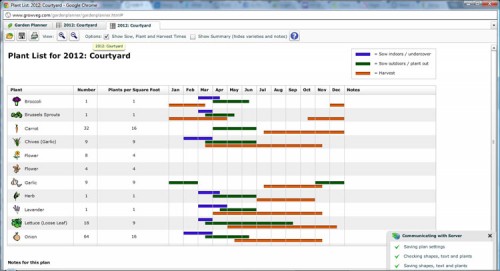If your garden is anything like my own, there is always a lot going on in your garden (and in your life) so the likelihood that you will remember how your plants grew or what made your tomatoes really flourish the year before is slim to none. And that’s why keeping a garden journal is just a good idea. Plus you can not only use it to remember what you’ve already done, but also to help you plan a schedule for maintenance, harvesting, canning & processing, seasonal planting and much more.
If you have been maintaining a garden but have not thought of keeping a journal, there is never a wrong time to start. But great times to start include the beginning of a season, the end of the season once you’ve wound everything done or whenever you are planning to revamp your garden. Whenever you are looking to get organized and want to make smart choices before you plant, a garden journal will come in handy. Plus it’s usual for crop rotation and companion planting too. Ultimately, your garden journal holds each and every plan that you have for your garden, with sketches of your garden plots and the delineation of which plant goes where.
There are other things that you can put in your garden journal. This includes things that you find useful for you and your garden. Some gardeners keep records of the following in their journal:
- Temperatures and rainfall – You can write down daily information regarding the weather and take note of unusual weather phenomena like very hot or cold spells and even including moments of very high rainfall or during drought. Then you can note down on the things you have done to protect your garden during extreme weathers and what plants survived and withered during those times.
- Planting and seasonal tasks – Journals can be used to remind you of the things that need to be done around the garden and when to do them. Planting seeds, pruning, watering schedules, fertilizing, weeding and the time for adding of organic materials can all be placed in that journal – or even added to a calendar in your journal or online. Anything that can be planned out ahead of time helps to ensure better garden results because you don’t have to think on the fly and constantly look up information about when to do what.
- Success and failures – Keeping a garden journal allows you to evaluate what grew well, which seed varieties to grow again, which of your seeds are no longer viable and much more, which will allow you to have a more successful and productive garden going forward.
There is no absolute rule on what your journal should look like. It is merely a personal tool to help you organize things in your garden but it’s a very helpful one. You can even put your own drawings of your plants and flowers or photos of them in it because keeping a journal can be fun!
I have personally used a few different methods which included a notebook, a looseleaf binder and earlier this year I started using a garden planning software (which was awesome for square foot gardening and crop rotation) plus Evernote to try out what I liked best. What’s important is to keep using the journal and not abandon it (which is the tricky part). I’m great about recording sprouting and growth of seedlings, and then after that I start to taper off, usually because I just get busy with other things (and we all know how that goes!) But no matter what, I create some sort of journal every year and stick to it as long as I can!
Do you use a garden journal? How do you keep yourself motivated to write in it all during the growing season?

Featured Posts from Last Week’s Natural Life Linky
From the submissions lately, you can sure tell it’s tomato season and everyone is trying to use the up in creative and delicious ways! Like with this oven-roasted tomato recipe from Amanda at Living on Grace — which didn’t go quite according to plan.
Or if you’re looking for something different, how about a Spinach, Butternut Squash Ravioli and Leek Lasagna?
Want to join in the fun and link to your own blog? You can share about anything related to natural living, from gardening to recipes to home remedies to anything else related to natural living.
Here’s how this works:
PLEASE READ THESE GUIDELINES, especially if you have never linked up before!
Posts you might want to link up could include:
- Green & natural living
- Real Food recipes
- Repurposing & upcycling ideas and projects
- Home remedies & aromatherapy
- Gardening goodness
- Sustainable smartness
- And other things related to living a more natural life
Here’s how this works:
- You are free to join the Natural Living link up at any time. You can also skip a few weeks and then come back. It’s entirely up to you.
- Please do not share more than 2 links per Link-up. If you do, I will delete the “extras.”
- Please link directly to the specific post on your blog that relates to green living — not your main blog URL.
- Please only link to your own blog or photos hosted online.
- Link back to No Ordinary Homestead or the Natural Living link up post in your blog post. This way, if someone else wants to join the fun, they can. You can either link with text or using the Natural Living badge. Below is a code for the badge above – feel free to resize it as you need. Just copy and paste this code into your post or save and upload the image to your blog: <a href=”https://www.noordinaryhomestead.com/category/natural-living/natural-living-link-up/“><img title=”natural living link up″ src=”https://www.noordinaryhomestead.com/wp-content/uploads/2012/08/noh-natural-living-linky.jpg” alt=”natural living link up” width=”300″ /></a>
- I highly encourage you to visit other participants and leave comments. This is a great way to meet new friends and become inspired about your garden! I try to visit all the blogs participating as well every week

That’s it! Share your green ideas with us by linking up at the bottom of this week’s Natural Living post!





This info is great — I always mean to keep a gardening journal and never do. I definitely should have this summer because our garden didn’t do well this year.
I run and race regularly and keep a running journal for the same reason, you never remember what works and what doesn’t and what the conditions were like you think you will!
Ravioli looks great !
I have a special little brown book that has sketches and very quick notes about do’s and don’t’s for future planting. I used to use it faithfully and got out of the habit. This year I knew I needed to reinstate it as I just can’t hold all the facts I wish I could in my memory these days.